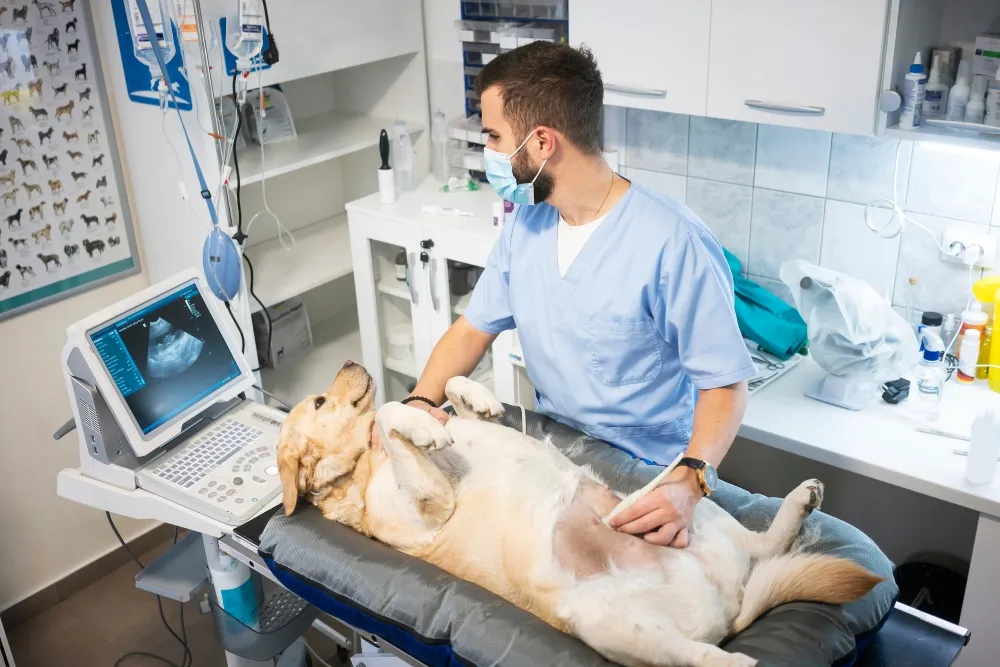Table of Contents
Are you wondering if your dog is pregnant? Maybe you’re hoping for puppies, or you’re worried that your newly-adopted dog is suddenly looking a bit “round.” Perhaps your pup came into heat sooner than expected and got out for a late-night gallivant around the neighborhood. Whatever the reason, you’re in the right place. Determining if a dog is pregnant is essential so you can care for her properly.
Signs of Pregnancy in Dogs
Dogs don’t make figuring out if they’re pregnant easy. After being in heat, every dog goes through the hormonal cycle associated with pregnancy. Because of these hormones, dogs who are not pregnant may look and act like they are. The more of the following signs of pregnancy in dogs that you see, the more likely a pregnancy is, but a dog’s false pregnancy can be very convincing.
Three Weeks After Breeding
The first pregnancy sign you might notice is the canine equivalent of morning sickness, which usually occurs around three weeks after breeding. Dogs may have a poor appetite or even vomit a few times, but they should return to normal within just a few days.
Five to Six Weeks After Breeding
More obvious signs start to develop a little more than halfway through a dog’s pregnancy. Your dog has probably put on some weight and her belly may be enlarging and starting to drop. Her nipples may be getting bigger and darker, and she could have lost some hair around them. These changes will become more noticeable as your dog’s pregnancy advances.
Days Before Birth
The average pregnancy for dogs lasts for about nine weeks. You may notice a little milky fluid leaking from your dog’s nipples a few days before she gives birth. Dogs often start nesting within days to hours of the start of labor.
A dog’s normal body temperature is 101.5 F, give or take a degree. A pregnant dog’s temperature will often drop dramatically 12 to 24 hours before she gives birth. Start taking your dog’s temperature twice a day about a week before her due date. If you get a reading in the 98-99 F range, expect puppies soon.
Pregnancy Testing in Dogs
Relying on physical signs alone is not a good way to determine if a dog is pregnant. Dog pregnancy tests can help you be sure and give you a lot of other good information.
Four Weeks After Breeding
Schedule an ultrasound with your veterinarian four weeks into your dog’s pregnancy. An ultrasound will:
- Confirm that your dog is pregnant
- Differentiate between a true and a false pregnancy
- Give you a rough idea as to the number of puppies in the litter
- Determine if the puppies have heartbeats
Blood tests for pregnancy can be run about 30 days after a dog has been bred but they don’t give as much information as an ultrasound, so they aren’t used as frequently.
Around Seven Weeks After Breeding
Abdominal radiographs (x-rays) taken a week or two before your dog’s due date are worth their weight in gold. At this point, the puppies’ skeletons show up well on radiographs. Your veterinarian can give you an accurate puppy count, which will let you know when your dog is done giving birth, as opposed to needing help to complete the process. If one or more puppies are exceptionally large, a cesarian section (C-section) may be necessary.
Unwanted Pregnancies in Dogs
You have a few options if you’ve just found out that your dog is pregnant but don’t want puppies. Pregnant dogs can be spayed, which will terminate the current pregnancy and prevent future ones. This is generally a better option early in a pregnancy. Medical pregnancy termination is also possible but is usually only considered for dogs who are part of a breeding program.
Of course, allowing the pregnancy to go to term is also possible, but you’re going to have lots of responsibilities during the next four months or so, including:
- Taking care of your dog during her entire pregnancy
- Monitoring the birthing process
- Taking care of your dog and her puppies for around eight weeks after birth
- Getting all the dogs any necessary veterinary care
- Finding good homes for the puppies
It’s always best to spay and neuter dogs before an unwanted pregnancy occurs.
How to Take Care of a Pregnant Dog
Few changes are required during the first six weeks of a dog’s pregnancy. Keep an eye on her health and well-being and feed her normal amounts of a high-quality, nutritionally complete and balanced adult dog food. She can continue her regular activities but don’t introduce anything new.
At the six-week mark, it’s time to gradually transition your dog to a puppy or all life stages food and to start feeding smaller meals more frequently. She’s going to need extra calories as her pregnancy advances and especially after she starts nursing her litter. Many dogs should also be dewormed to help protect the pups from intestinal parasites.
Pregnant dogs can continue to exercise but shouldn’t do anything too strenuous—leash walks are great! Keep your dog away from other dogs during the last three weeks of her pregnancy to prevent canine herpes virus infection, which can lead to stillbirths and neonatal death. Mom and pups should be isolated for another three weeks after birth.
Set up your dog’s whelping box at least a week before her due date so she feels comfortable in it before she goes into labor.
Talk to Your Veterinarian
Your veterinarian is the best source of information that is tailored to your dog’s particular needs. Talk to your vet early on in your dog’s pregnancy so you can plan for her care before, during, and after the big day.








